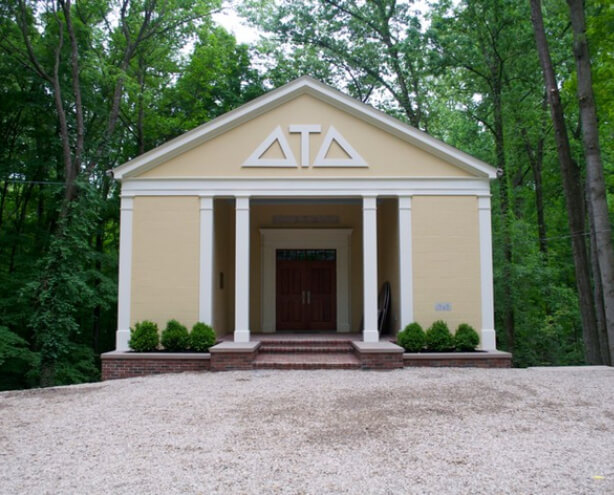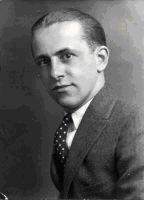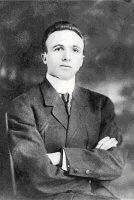In compiling this history of Chi Chapter of Delta Tau Delta, Brother Rufus Southworth has rendered a service of inestimable value to all the members of Chi. He has done a job which few others could have done as well, for he has known personally and associated intimately with men whose membership in Chi goes back to the first years of the chapter’s life and to whose devotion and loyalty we are indebted for the Chi of today.
For years I had been trying to induce some qualified member of Chi to undertake this task that “Brick” has done so well. Because of my failure in this effort, I had decided to attempt writing this history myself. With this end in view, I wrote to many of our alumni for information concerning their years as actives, and I received most helpful letters in reply. In addition, there came from Brother Southworth an offer to come to Gambier and to relieve me of the details involved in the compiling of this history. I gladly accepted this offer and turned over to him the material I had gathered. I was also privileged to assist him in his work, to take several suggestions, to edit his manuscript and to put it into final form. I am confident that this story of the live of Chapter Chi will be a source of information and of inspiration for many years to come.
W.C. Seitz, 1915
Gambier, 1941

This history and the above foreword were written over 25 years ago. At that time, many of our older alumni, while deeply appreciative of Brother Southworth’s work, felt that it should not be generally circulated. They feared that his account of the difficulties placed in the way of Chi Chapter during its early years might tend to revive long forgotten animosities.
I am of the opinion that the need for such reticence no longer exists.

In the first place, there was formerly no accepted code of conduct governing interfraternity relations. Any weapon – detraction, innuendo, even falsehood – seemed justified in what was often internecine warfare (e.g., “jumping” from one fraternity to another was not regarded as evidence of moral depravity). So, we should judge the opposition, which Chi Chapter early faced and the tactics used against it not by the uncompromising standards of honor that characterized Brick Southworth but by the accepted practices of the 1980s.
In the second place, the enrollment at Kenyon College was, during these years of Chi Chapter’s difficulties, at a very low figure. One of our alumni has stated that during his freshman year, there were 29 students in the entire college. Those opposed to the introduction of Chi Chapter argued that since Kenyon College already had chapters of five national fraternities, there was no real need of a sixth. Even we members of Delta Tau Delta would have to concede that their position was not without justification.
In the third place, we must remember that the difficulties faced by Chi Chapter were not unique. At one time, the membership of the chapter shrank to one man. Alumni of two of the older fraternities represented at Kenyon have informed me that the membership in their respective chapters was at one time likewise reduced to one man. Another chapter at Kenyon had no actives for a full year and had to be revived by returning alumni. A fourth lost its charter and passed out of existence. The story of Chi Chapter must be read with these facts in mind.
W.C.S.
Gambier, 1966
The Founding of Chi
The history of Chi Chapter is inspiring. It is the record of love and devotion to the lofty ideals of Delta Tau Delta. Moreover, it is the chronicle of toll, of hardship, of dark days endured by men who never knew defeat, even when the outlook was dreary enough to have utterly discouraged men cast in a less heroic mold. Happily, it is also the history of brilliant success, high achievement, a victory well earned as the result of a race nobly run.
Just as Old Kenyon is composed of many stones – some large, some small, but each fitting into its assigned place – so the Chi Chapter roll lists a host of men who performed their duties in such a manner as to build the solid, virile, impressive structures that is Chapter Chi.
Chi Chapter was born January 26, 1881, when the Delta Badge was pinned on the breasts of its first initiates. Chi’s founders were Edwin J. Franks ’81, William A. Childs ’83, Andrew L. Herrlinger ’83, Charles J. Suhr ’83, Alfred A. Taltavall ’83, Henry Critchfield ’84, Ichigi Sano ’84 and Charles S. Crawford ’83.




A Decade of Struggle
In the days of goodwill between fraternities and their chapters, it is almost impossible to imagine the opposition to the establishment of this youngest chapter of the youngest fraternity then represented at Kenyon. A new chapter of another fraternity had been installed on the Hill only a year before. There were less than 60 men in the college. The older fraternities represented at Kenyon feared that if the new chapter, Chi, were to live, sooner or later one or more of their number would die – a foreboding that came to pass 15 years later.
The first move of the opposition was to petition the faculty to order Chi to disband. During several faculty meetings, this petition was ardently, even fiercely, debated. One professor, himself a member of the Yale chapter of one of the rival groups, held out for the recognition of Chi. His citing of the argument of Gamaliel won the day. Without his support, infant Chi Chapter would have died aborning.
[This unnamed advocate was none other than the author’s father, Professor George C.S. Southworth. W.C.S.]
Since it proved impossible to kill Chi by faculty action, efforts were made to “jump” the individual members of Chi. Alluring prospects of social and financial benefits, both in Kenyon and especially throughout their careers after graduation, were artfully offered to several, perhaps all, of the Chi initiates.
 Now, securely entrenched behind the bulwarks of the powerful defense provided by 60 years of growth and achievement, as well as the support offered by our 80-year-old national fraternity, composed of men honored and trusted the country over, it is well-nigh impossible for Chi men or other Delts of today to realize the force of such an appeal to self-interest.
Now, securely entrenched behind the bulwarks of the powerful defense provided by 60 years of growth and achievement, as well as the support offered by our 80-year-old national fraternity, composed of men honored and trusted the country over, it is well-nigh impossible for Chi men or other Delts of today to realize the force of such an appeal to self-interest.
Remember! In 1881, the fraternity was scarcely more than 20 years old – much too young to show more that a faint indication of its future greatness. In fact, a much-used argument, employed by her enemies in the ’80s, was the statement, made brazenly at first, and later by insinuation, that Delta Tau Delta was not, in truth, a national fraternity.
Let it be emblazoned in gold, to the everlasting glory of the founders of Chi Chapter and their successors, that there was but one member who “jumped.”
Chi Chapter faced, however, a third threat to its continued existence. The college enrollment continued to be so small and consequent competitive struggle for pledges was so keen that in the late ’80s but one member of Chi remained in college. But what a man he was!
Mentorship
The Byron J. Horn Leadership Program was established in 2012 to honor, preserve and carry forward the memory of Byron Horn (DTD ’86) as an exemplary leader, scholar, athlete, attorney, husband, father, and friend. The program provides leadership and career development opportunities to undergraduate members of Delta Tau Delta at Kenyon.
The Byron J. Horn Leadership Program has four goals:
1. Honor, preserve and carry forward the memory of Byron Horn as an exemplary leader, scholar, athlete, attorney, husband, father, and friend.
2. Squarely address the career development needs of Kenyon students.
3. Enable Delt Alumni to maintain a dynamic and meaningful connection to Chi.
4. Demonstrate Chi Delt leadership and “value added” to the Kenyon Community.
Alumni can get involved in two ways:
1. Become a mentor to an undergraduate Delt.
2. Meet with the Chapter and discuss your personal career path, education and engage in a short question and answer session.
